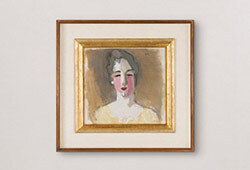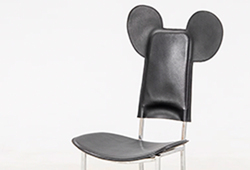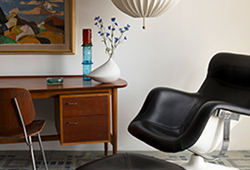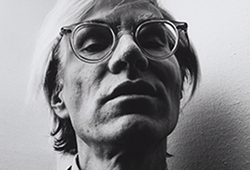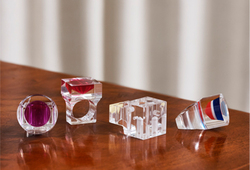Lennart Rodhe
"Snurran"
Signed with monogram and dated -48. Also signed and dated verso Lennart Rodhe 1948. Tempera on panel 101 x 121 cm.
Provenance
Galerie Bel'Art, Stockholm.
Private Collection.
Exhibitions
Galerie Bel'Art, Stockholm. "Lennart Rodhe - The Triangle Theme: 1947 - 1948, 29 October - 30 November, 2005".
Literature
Rolf Söderberg, "Den svenska konsten under 1900-talet", 1961, compare fig. 17, p. 230 black and white invitation card of "Snurran".
Thomas Millroth, "Lennart Rodhe", SAK, 1989. The theme Snurran mentioned on pp. 50-51.
Thomas Millroth (ed), "Lennart Rodhe", Atlantis, 1990, Illustrated and listed in the list of works as no 31 p. 126.
More information
Lennart Rodhe's visit to Paris in the fall of 1947 was an important experience. After the confines of the war years, Rodhe was drawn to travel across Europe, and his journey began in Paris. Accompanied by his then-wife Eivor Burbeck, they spent several weeks visiting museums, galleries, and fellow Swedish artists, including Lage Lindell. Rodhe had a commission from Bonniers förlag for a book cover for "Den ointresserade mördaren" by Tord Herne. He found inspiration for the cover in Paris when he came across a folder of reproductions by the avant-garde photographer Germaine Krull. The folder titled "Metal" from 1928 contained 64 images of robust metal constructions such as cranes, bridges, railways, and power stations captured in close-ups or from breathtaking camera angles. The photograph of the Eiffel Tower taken from below left a strong impression on Rodhe, inspiring the book cover for Bonniers and marking the beginning of a new direction in his art, centered around the theme of triangles.
During the summer of 1948, Rodhe worked on depicting space and movement using only the simplest of geometric shapes, the triangle. When using triangles exclusively, the spatial depth of the image often remained shallower than desired. Through contrasting colors, a certain depth could be created, but it was challenging to create an illusion of movement in the picture. A triangle seen from the side remains a triangle, just slightly narrower, and it stays on the surface of the image. By incorporating ellipses into the triangles, as in 'Snurran,' an optical impression of movement in the picture was created. The eye perceives the ellipse as a circle, tilted diagonally, causing the triangles to appear to move in different directions.
The first sketch for "Snurran" is dated December 4, 1947. It was made on black Ingres paper with tempera white and ink (see image from exhibition invitation card, Ny Realitet. Östersund 1949).
Through repetition and coloration, Rodhe achieved perspective and depth, but he did not apply principles mechanically. An odd shape could disrupt the order and lead to an entirely different outcome. A new color could enter entirely without justification, without being part of a larger context.
Rodhe was the first among his peers to receive major commissions. From 1948 to 1953, he worked on the "Trappan" theme for Ängby School, and from 1948 to 1952, he worked on "Paket i långa banor" for the post office in Östersund. The initial sketches for "Trappan," executed on cardboard and mounted on the wall, included both "Drakar" and "Snurran," two motifs found in this auction (see photo). In the final version of "Trappan" for the drawing room in Ängbyskolan, the spiral form of the staircase took up more space, and the strict form varied across the entire wall surface.
The initial public commissions were followed by more, such as Astra's dining hall in Södertälje, stained glass windows for Svenska Handelsbanken, stoneware walls for Dagens Nyheter, textiles for the National Archives and the Riksbank, among others, and two large carpets for Thielska Galleriet. Lennart Rodhe dedicated much of his artistic life to monumental tasks. He dreamed that monumental works would be everyone's property and could be viewed and judged by as many people as possible. He was greatly disappointed that public art was not always preserved for the future. Some of Lennart Rodhe's public works can no longer be seen.





